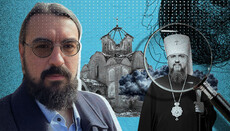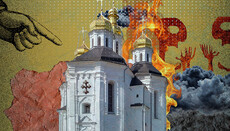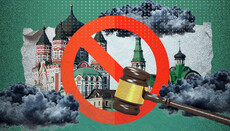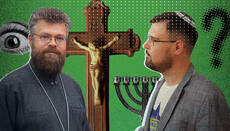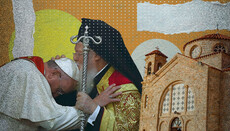The third union of Constantinople with Rome: the contours are clearer
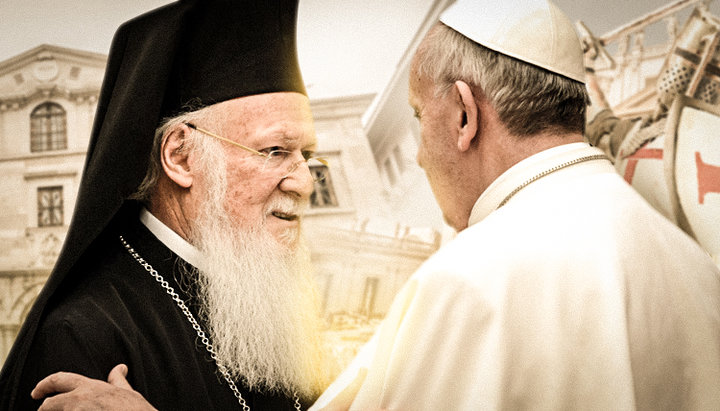
The Pope and Patriarch Bartholomew once again declared the common Eucharist in the future. Does this mean that a new union is only a matter of time?
V.O. Klyuchevsky said: "History is a lantern into the future that shines for us from the past." Today, Patriarch Bartholomew is so actively leading his followers to union with Rome that this can no longer be ignored, it cannot be denied.
More recently, on November 30, the Phanar celebrated its patronal feast – the memory of the Apostle Andrew the First-Called. There were no representatives of the Local Churches at the festive Liturgy, but the Vatican delegation was present. At the sermon, Patriarch Bartholomew said that for him every personal meeting with Pope Francis is "a special experience of brotherhood", which strengthens the desire on both sides "to go hand in hand, fighting on the path to the common cup of the Eucharist".
In the message to Patriarch Bartholomew on the occasion of the feast of the Holy Apostle Andrew the First-Called on November 30, 2020, Pope Francis stated: “We can thank God that relations between the Catholic Church and the Ecumenical Patriarchate have grown much over the past century, even as we continue to yearn for the goal of the restoration of full communion expressed through participation at the same Eucharistic altar. Despite the existing obstacles, I believe that by walking together in mutual love and pursuing theological dialogue, we will reach that goal.”
It is easy to see that in the words of both Pope Francis and Patriarch Bartholomew the same thesis sounded – confidence in the “participation at the same Eucharistic altar”. This is possible only in one Church. Therefore, we have the right to predict that there will be a union, the only question is when? And one more question arises – who will participate in this? History can tell us the answers.
In the words of both Pope Francis and Patriarch Bartholomew the same thesis sounded – confidence in the “participation at the same Eucharistic altar”. This is possible only in one Church.
The Patriarchate of Constantinople tried to organize a union with the Vatican twice.
Unions of Lyons and Florentine
The first time was in 1274 in Lyons. From 1204 to 1261, there was the Latin Empire, formed as a result of the destruction of the Byzantine Empire by the crusaders during the Fourth Crusade. By the way, just after the Fourth Campaign, which was directed against Orthodox Christians rather than infidels, it became clear that the Latins were no longer co-religionists but merciless enemies. And this is not the opinion of the hierarchy and theologians, it was felt by ordinary people with whom the crusaders behaved extremely cruelly. After the expulsion of the Latins from Constantinople by Emperor Michael VIII Palaeologus, the former head of the Latin Empire Baldwin II went to the West and pleaded with the Pope and European sovereigns to help him return Constantinople.
Pope Urban IV, who was entirely on his side, began to spread proclamations calling for a new crusade against Constantinople. And Baldwin's father-in-law Charles I of Anjou, who was then a very powerful ruler, began military preparations for a future war with the Greeks. At the same time, the Bulgarians and the inhabitants of the Peloponnese were at odds with the restored Byzantine Empire. In addition, within the empire itself, there was a threat of uprising, in connection with the illegal accession to the throne of Michael Palaeologus himself.
And it was under these conditions that the Emperor put Orthodoxy at the feet of Rome in exchange for political support. Negotiations about this with Pope Urban IV, Clement IV and Gregory X, who quickly replaced each other, led to the signing of the Union of Lyons, according to which the Orthodox Church in Byzantium accepted all Catholic teachings and submitted to the Pope.
The second attempt at union took place in 1439 in Florence. The then Emperor John VIII Palaeologus also needed military assistance and political support from the Pope. And he also planned to pay off with Orthodoxy.
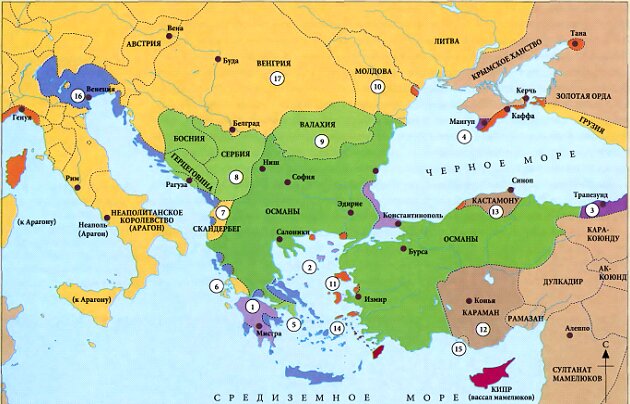
The Ottoman Turks surrounded Constantinople on all sides, and the Greeks made desperate attempts to somehow try to preserve the Empire. In 1437, John Palaeologus took a delegation of bishops to Italy to trade Orthodoxy and forbade them to leave the Ferraro-Florentine Сouncil without signing a document that subordinated the Orthodox Church to the Pope. Only a few bishops, headed by Saint Mark of Ephesus, refused to sign. An interesting detail: one of these bishops, in order to avoid signing, pretended to be crazy, while the other simply fled. The Union did not help – in 1453 Constantinople was captured by the Ottoman Turks, led by Sultan Mehmed II.
Both of these Unions were not implemented in practice, since the Orthodox clergy and the people did not accept them. The supporters of the union were treated as traitors. The contempt for them was so strong that, according to historical sources, even touching them was considered a desecration.
What unites these two unions is not only that they remained only on paper, but also the motive for which they were concluded. This motive is political.
What unites these two unions is not only that they remained only on paper, but also the motive for which they were concluded. This motive is political. Constantinople, in the face of a real threat to end its existence as a state, and the emperors, under a real threat of losing their personal power, tried to exchange their most valuable asset – Orthodoxy – for the support of the West. The hierarchs, led by the Patriarchs of Constantinople, indulged them in this, and those who expressed disagreement were sent to prison and exile. Christ did not create his Church as an asset and did not hand Her over to the Byzantine emperors with the ability to dispose at its own discretion, but the circumstances of the conclusion of both Unions indicate that the attitude towards the Church was just like that.
Dreams of reviving past greatness
Now, through the prism of the above-mentioned historical events, let's look at the current actions of the Patriarchate of Constantinople.
In the words of the Pope and Patriarch Bartholomew given at the beginning of the article, one cannot but notice confidence in the unification of the Vatican and the Phanar, although the words “we will reach” can be understood in two ways. If "we" are the Pope and the Patriarch, then unification is seen in the near future due to the advanced age of both. If "we" are the Phanar and the Vatican, then the perspective may be postponed to a later date. But one should pay attention to the fact that Pope Francis speaks about the intensification of the dialogue over the last century. History testifies that this is indeed the case. It is also true that during this century the Patriarchate of Constantinople has experienced heavy blows from history, which eventually brought it to the brink of complete disappearance.
If in 1914, according to various estimates, from 1.7 to 2.3 million Greeks lived on the territory of the Ottoman Empire, and the Patriarch of Constantinople was not only the religious leader of the Orthodox Christians of the empire but also the secular head of this "Rūm Millet". Then ten years later after the First World War, the Asia Minor catastrophe, the Genocide of the Pontic Greeks and the Greek-Turkish population exchange, which ended all these events, a little more than 200 thousand ethnic Greeks remained in Turkey, and over the next hundred years, their number only decreased. Today, about 2-3 thousand Greeks live in Turkey. These are mainly employees of the Patriarchate of Constantinople and members of their families. It should be noted that there are much more ethnic Greeks in Turkey, according to various estimates from 400 thousand to 4 million, but the fact is that these are Muslim Greeks who have nothing to do with the Patriarchate of Constantinople.
After the terrible stories about the tragedy of the Greek population of the Ottoman Empire at the beginning of the 20th century, the first thing that comes to mind is the question: why did the Patriarch of Constantinople not follow his flock during the population exchange? After all, the Gospel speaks quite clearly of what a good shepherd should be like “...The good shepherd lays down his life for the sheep. The hired hand is not the shepherd and does not own the sheep. So, when he sees the wolf coming, he abandons the sheep and runs away. Then the wolf attacks the flock and scatters it. The man runs away because he is a hired hand and cares nothing for the sheep.” (John 10: 11-13). The fact that the Patriarch of Constantinople remained in Turkey while his flock was practically all exiled mainly to Greece is understandable not from the point of view of the Gospel, but from the point of view of Greek nationalism.
The Patriarch stayed in Istanbul to “keep the place”, to be a symbol of the former Greek greatness, and to nourish the hope of the Greeks that someday they will return and Constantinople will again become the magnificent capital of the revived empire. That is why the Patriarchs of Constantinople endure humiliation and oppression both by the Turkish authorities and by the unfriendly local population. Perhaps, this is commendable from the point of view of the Greek national identity, but it must be recognized that such an attitude does not have a gospel basis. The Gospel rather gives a negative assessment to such national identity. After all, this is very similar to the aspirations of the Jews in the time of Christ that the Messiah will have to revive the Kingdom of David on earth, and that the Jews will rule over all nations. And Christ's refusal to realize these aspirations was the impetus for the people who exclaimed at the Lord's Entry into Jerusalem: "Hosanna to the Son of David!" a few days later they yelled: "Crucify, crucify Him!"
Perhaps, someday there will be a triumphant return of the Greeks to Constantinople, but so far we’ve been observing how the Turkish authorities are consistently squeezing the Patriarchate of Constantinople from their territory. In 1954, with the connivance of the authorities, a pogrom of the patriarchate took place. In 1955 there was a similar pogrom of the Greek community in Constantinople. In 1971, Turkey closed the Theological School on the island of Halki. In 1994, an explosive device was planted in the church of St. George. Then it was successfully neutralized, but in 1996 there was an explosion in the temple. In 2020, the Hagia Sophia, which had the status of a museum, was turned into a mosque. And this is not a complete list.
The triumphant return of the Greeks to Constantinople is not yet visible, but the prospect of the eviction of the Patriarchate of Constantinople from Turkey is becoming more and more real. Under these conditions, history repeats itself – the Patriarchate of Constantinople is trying to find help in the Vatican and is ready to go to union with Rome for this. It is difficult to say what exactly it counts on, but one thing is certain - if the Phanar did not experience such problems as it is now, if it had a multimillion flock as before, if it were not threatened with eviction from Constantinople, etc., then it would not throw itself into the arms of the Vatican. After all, preparing for the union is a huge risk. Two past attempts indicate that those emperors and patriarchs who started them ended very badly. The clergy and people simply refused to obey them. Therefore, before making another attempt, the Patriarchs of Constantinople are trying to consolidate their power in Orthodoxy. And this has also been seen over the past hundred years.
Two past attempts indicate that those emperors and patriarchs who started them ended very badly. The clergy and people simply refused to obey them. Therefore, before making another attempt, the Patriarchs of Constantinople are trying to consolidate their power in Orthodoxy.
Become the First to bring the Church into the union?
Recently, the doctrine of the alleged primacy of the power of the Patriarch of Constantinople has already been finally formed and systematized. It is most fully expressed in the treatise of the current head of the Archdiocese of America, Archbishop Elpidiphoros (Lambriniadis): "The First without equals." This treatise ends with the following words: “The primacy of the Archbishop of Constantinople, as we have already said, has nothing to do with diptychs, merely expressing a hierarchical order (which, in contradictory definitions, the document of the Moscow Patriarchate recognizes to some extent, but in fact denies). If we talk about the source of primacy, then such a source is the very personality of the Archbishop of Constantinople, who, as a bishop, is a First "among equals", but as the Archbishop of Constantinople and, accordingly, the Ecumenical Patriarch is a First without equals (primus sine paribus)."
He is echoed by one of the most famous Greek theologians, Metropolitan Hierotheos (Vlachos) of Nafpaktos of the Greek Orthodox Church: “The Ecumenical Patriarch has a number of tasks that have been recognized in practice by all Orthodox Churches. Among them is the one that he presides over Councils and grants autocephaly. Who has these exclusive privileges and responsibilities? Anyone who denies them will have to reject all autocephalous Churches and autocephaly, which the patriarchate has granted to the younger (Churches – Ed.). <...> The Ecumenical Patriarch is the first to form the unity of the Church in the image (or by the image – Ed.) of Christ, without being a "vicar of Christ" <...> He who does not stay in communion with the First (the Patriarch of Constantinople – Ed.), he, together with his Synod, is cut off from the church community.”
And the apogee of the perverted understanding of the very nature of the Church is the statement of the Metropolitan Amphilochios of Adrianople of the Greek Church: “There is an opinion that the Orthodox Church is headed by Jesus Christ. But in reality, the Church is headed by the Ecumenical Patriarch."
Archimandrite Sofroniy (Sakharov) (1896-1993), who, by the way, was in the bosom of the Church of Constantinople and was canonized by it a year ago, warned that such a worldview of the Phanar would inevitably lead to the denial of the dogma about the Church in the form in which it was formulated at the Second Ecumenical Council in 381:
“At present, in the depths of our Holy Church, there is a great danger of perverting the dogmatic teaching about Her, and hence the danger of perverting Her being, because dogmatic consciousness is organically linked with the whole course of inner spiritual life. <…> The loss of dogmatic truth, by its irreparable consequence, will have the loss of the possibility of true knowledge of God, the fullness of which is given to the Church. <...> If we now distort the teaching about the Church, and, consequently, the image of Her being, then how can She serve Her sons on the path to Truth? You may ask, but where is this distortion seen now? We answer: in Constantinople neo-papism, which is quickly trying to move from a theoretical phase to a practical one.”
It can be assumed that by no means all the bishops of the Patriarchate of Constantinople share the aspiration of Patriarch Bartholomew for the leadership in the Church. If we look at the situation that developed in the Greek, Cypriot and less expressed in the Alexandrian Churches after their recognition of the Orthodox Church of Ukraine, this symbol of the Phanar's primacy, we will see that there are many bishops there who sharply opposed such recognition. Moreover, this disagreement was supported by such strong argumentation that, for example, the Primate of the Church of Cyprus, Archbishop Chrysostomos, did not find other arguments other than the threats to depose them. In the Church of Constantinople itself, the episcopate so far has tacitly agreed with the policy of Patriarch Bartholomew and other supporters of Constantinople neo-papism, but soon the moment of truth may come when it is necessary to make an “either-or” choice.
Presumably, such a moment will come in 2025 during the celebration of the 1700th anniversary of the First Ecumenical Council. There is no better reason for Patriarch Bartholomew and Pope Francis to unite at some level the church structures they lead. In 325, at the First Ecumenical Council in Nicea, firstly, there was one Church both in the West and in the East, and secondly, questions about the Filioque and the Pope’s primacy were not raised at all.
True, the Church of Constantinople did not exist as such then since there was no Constantinople. The Holy Emperor Constantine the Great moved the capital of the empire to the town of Byzantium only in 330 and until the Second Ecumenical Council (381) the city was under the jurisdiction of the Metropolitan of Heraclius. But no one will remember this annoying misunderstanding. And at this time, very soon, the Greek clergy and people will have to show whether they are worthy of the memory of their ancestors who did not accept the Unions of Lyons and Florentine. I would like to believe that the same inglorious end awaits the new union.
However, time will show ...
